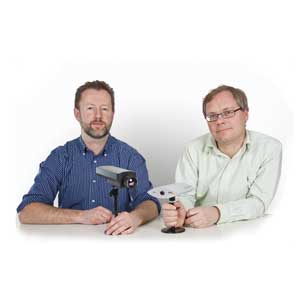
|
| Gren (right), the inventor of the network camera, and the co-founder of Axis communications and North American general manager, Fredrik Nilsson, toast with champagne and cupcakes at ASIS in Orlando. |
Nine Questions With Martin Gren, the Network Camera’s Inventor
In September of 1996, Axis Communications, Chelmsford, Mass., launched the world’s first IP camera at a tradeshow in the United States. Fast forward to 2011, where at ASIS in Orlando, Fla., Axis took the opportunity to celebrate the 15th anniversary of the invention of the first network camera with attendees. Cupcakes, a champagne toast, speeches, and Martin-Gren-autographed AXIS M1011 network cameras all were part of the program.
Before the show, SDM had the chance to interview Gren, the inventor of the network camera, and the co-founder of Axis Communications in 1984 with Mikael Karlsson and Keith Bloodworth. Gren shared some of the lesser-known details of the journey to the first network camera.
SDM: What made you decide to start working on a network camera?
GREN: When Axis was founded in the mid-‘80s, we specialized in IBM printing. As the business of mainframes started to decline, we saw that our little company couldn’t live on just one technology for too long. So while the print server business ran quite well for more than 10 years, the Axis culture became one of exploring new ventures for products that “made your network smarter.” In this open technology atmosphere, we launched products like TCP/IP print servers and networked optical storage — which the now North American general manager Fredrik Nilsson actually wrote manuals for back then.
In the early ‘90s while on a business trip in Tokyo, I met a customer with an inventory of unsellable analog cameras and he asked if we could network-attach them. I thought it was a cool idea (and funny enough still a common problem today).
Coincidentally, one of our engineers named Carl-Axel Alm (who is still with Axis today) had been working on a network video conference system. When I got back from Tokyo and saw what he was working on, I said, “Let’s scrap the use of it as a video conference system. I do not believe in that market and it does not fit the Axis way of doing business. But your hardware is great for creating a network camera, so let’s do that instead.”
We all agreed and, many student master theses later, the world’s first network camera was launched in 1996!
SDM: What events surrounding the journey — from the first idea to the final product — still stick with you today and why?
GREN: We had the idea of the first network cameras just before the dotcom boom and before anyone outside of network engineers knew what the World Wide Web was. Thanks to our innovative culture, Axis was quite early having Internet email in 1988. So when we developed the first models of the network camera, it was based on various semi-open standards. These were a nightmare to install on our PCs (this was pre Windows 95).
After many trials on creating a software driver, we finally came up with the idea of using a Web browser as the viewer for the camera. This realization immediately changed our direction and led us to make the camera a Web-server with live pictures — much inspired by the MIT Trojan Room coffee pot camera.
Looking back at the original network camera, there are many things still in common with today’s cameras. The camera is still a Web-server and has a GUI (graphical user interface). We had an API (application programming interface) that we later named VAPIX 1.0, which was an easy-to-use HTTP-based interface.
SDM: Was there ever a time you didn’t think it would work?
GREN: Just before we got the idea of using a Web browser to interface the camera, we were close to giving up. Writing an image driver in a platform-independent way was almost impossible. We were quite frustrated trying to get the first unit to work. But the day we decided to use a browser, all the ideas fell into place and we were thrilled.
SDM: What did you first originally call the completed invention and why? (Did it have a ‘working’ name?)
GREN: We had long, long discussions on what to call it. “Network camera” was something we all agreed upon, but internally we wanted to come up with a name — not a number. After a lot of internal debate, and a lot of beer, we came up with the name “Neteye.” But we soon learned it was expensive to register a second trademark so, after some time, we decided to simply call it the AXIS 200 network camera. I’m glad to say though that the name Neteye still lives on internally as part of our culture. The U.S. office has named one of its conference rooms after it.

|
| Gren (right) and his co-inventor, Carl-Axel Alm, at the time of the invention of the network camera. |
SDM: Had you ever invented anything else before this?
GREN: We have not invented a specific category like we did with the network camera and the video encoder. But we have tweaked a lot of products into something completely new and different, such as print servers that supported multiple protocols and optical network servers with built-in hard disks. We were actually one of the first companies in the world who had embedded network attached storage (NAS), but it was 10 years before the technology was practically useful. So if we hadn’t invented the network camera we probably would have been a network storage company!
SDM: What were your initial expectations for the network camera? Did you expect the network camera would be what it is today?
GREN: Well, both yes and no. The Web browser realization was a game-changer and we knew we were onto something big. Still, that initial camera was meant for Web attraction. We went to various tradeshows in different markets and saw one that was 100 percent analog and based on a 50-year-old standard. Just like many of the dotcommers of the time, we said we could change this way of doing things in just a couple of years if we could make CCTV systems network-based and add remote monitoring capabilities.
In my presentation to the Axis board of directors, I said it was an amazing opportunity. The board said, “If you can sell 5,000 by this date, we will make it a permanent business unit of the company.” We sold more than 10,000. We then decided on doing the ASIC chip and started on our path to becoming a network video company.
SDM: How long did the process take, from first step of the invention to finished camera that could be sold?
GREN: It took about three years in all. First was the idea of the video conference system, then the frustration of not finding a common, open platform way to do it. And finally the Q&A process delayed the launch by six months. We had a prototype with us in the spring of 1996 to show it at CEbit in Germany, but decided to not show the product until it was ready, which turned out to be N+I in Atlanta in September that year. Fifteen years later and we still refuse to announce a product until we have working units in hand.
SDM: We have to ask: What happened to the first network camera – is it still around?
GREN: It’s still alive and kicking. I collected a bunch of them over the years and most still work! The only problem with those models is the battery for its real time clock, which was specified to last for five years. When testing a few of the original Neteyes, I actually found one where the time was still running — although it had drifted four hours off. Not too bad for 15 years and a battery working 10 years overtime.
